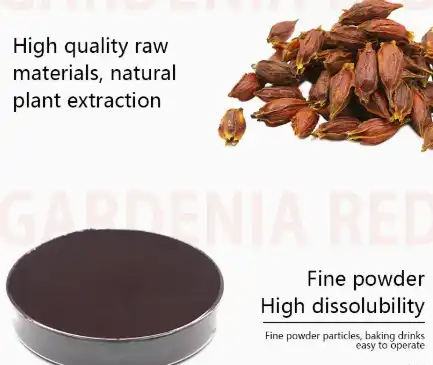Gardenia Red Powder, derived from the fruits of Gardenia jasminoides, has gained significant attention in various industries due to its vibrant color and potential health benefits. This natural pigment has been used for centuries in traditional medicine and as a coloring agent in food and cosmetics. In this comprehensive guide, we'll explore the various aspects of product including its production, applications, and potential health benefits. Whether you're a food manufacturer, cosmetic formulator, or health enthusiast, this article will provide valuable insights into this versatile natural product.

What are the main uses of Gardenia Red Powder in the food industry?
Natural food coloring agent
Gardenia Red Powder has come decreasingly popular as a natural food coloring agent in the food assiduity. As consumers come more health-conscious and demand cleanser markers, manufacturers are turning to natural druthers
to synthetic food colorings. It offers a vibrant red tinge that can be used in a wide range of food products, from potables to confectionary. The greasepaint is deduced from the fruit of the Gardenia jasminoides factory, which contains crocins, the composites responsible for its rich color. Unlike some synthetic food colorings, it is considered safe for consumption and does n't pose the same health enterprises associated with artificial colorings. Food manufacturers appreciate its stability and versatility, as it can be used in colorful pH conditions and repel certain processing temperatures. also, it can be fluently blended with other natural colorings to produce a wide diapason of tones, making it a precious tool for food product inventors seeking to produce visually charming and natural- looking products.
Flavor enhancer in traditional cuisines
Beyond its part as a coloring agent, Gardenia Red Powder has been used as a flavor enhancer in colorful traditional cookeries, particularly in Asian countries. The greasepaint imparts a subtle, gooey flavor that can round and enhance the taste of certain dishes. In Chinese cookery, for illustration, it is occasionally used in the medication of red incentive rice, a traditional component known for its unique flavor profile and implicit health benefits. The greasepaint can also be set up in some traditional herbal tea composites, where it contributes both color and a mild, affable taste. In Japanese cookery, it is sometimes used as a natural volition to saffron, furnishing a analogous tinge and subtle flavor to dishes like rice and mists. While its flavor- enhancing parcels may be subtle, the use of it in traditional fashions frequently serves a binary purpose of adding both visual appeal and a nuanced taste to the final dish.
Functional food ingredient
In recent times, there has been growing interest in the implicit health benefits of Gardenia Red Powder, leading to its use as a functional food component. The greasepaint contains colorful bioactive composites, including crocins and crocetin, which have been studied for their implicit antioxidant andanti-inflammatory parcels. As a result, some food manufacturers have begun incorporating it into functional food products aimed at promoting overall health and well- being. For illustration, it may be added to nutritive supplements, fortified potables, or heartiness- concentrated snack bars. Some studies suggest that the composites set up in it may have implicit benefits for cardiovascular health, cognitive function, and metabolic health, although further exploration is demanded to completely understand these goods. As consumers come decreasingly interested in foods that offer health benefits beyond introductory nutrition, the use of Gardenia Red Powder as a functional component is likely to expand. still, it's important to note that while promising, the health claims associated with it should be approached with caution until further comprehensive clinical studies are conducted.
How is Gardenia Red Powder used in the cosmetics and personal care industry?
Natural colorant for cosmetics
Gardenia Red Powder has found a significant place in the cosmetics and personal care industry as a natural colorant. With the growing demand for clean beauty products and natural ingredients, many cosmetic manufacturers are turning to plant-based pigments like it to replace synthetic dyes. This versatile powder can be used in a wide range of cosmetic products, including lipsticks, blushes, eye shadows, and even nail polishes. The vibrant red hue of it can be adjusted to create various shades of pink, coral, and deep red, making it a valuable asset for cosmetic formulators. One of the advantages of using it in cosmetics is its stability and ability to blend well with other ingredients. It can provide long-lasting color without the need for harsh chemical fixatives. Additionally, as a natural ingredient, it aligns well with the clean beauty movement, appealing to consumers who are looking for products with simpler, more natural formulations. Cosmetic companies often highlight the use of Gardenia Red Powder in their marketing, emphasizing its natural origin and potential skin-friendly properties.
Potential skin care benefits
Beyond its role as a colorant, Gardenia Red Powder is being explored for its potential skin care benefits. The powder contains antioxidants, particularly crocins, which may help protect the skin from oxidative stress and free radical damage. Some skincare formulations incorporate it for its potential anti-aging properties, as antioxidants are known to help combat the signs of premature aging. There is also some evidence to suggest that compounds found in it may have anti-inflammatory properties, which could be beneficial for those with sensitive or irritated skin. Some skincare brands are incorporating it into products such as face masks, serums, and moisturizers, touting its potential to brighten and even out skin tone. While more research is needed to fully understand the skin care benefits of Gardenia Red Powder, its natural origin and potential antioxidant properties make it an attractive ingredient for many consumers seeking natural skincare solutions. As with any new skincare ingredient, it's important for individuals to patch test products containing Gardenia Red Powder and consult with a dermatologist if they have any concerns.
Hair care applications
Gardenia Red Powder has also found its way into hair care products, offering both coloring and potential hair health benefits. As a natural hair dye, Gardenia Red Powder can impart a range of red and reddish-brown hues to hair, providing an alternative to chemical-based hair dyes for those seeking a more natural approach. The powder can be mixed with other natural ingredients like henna to create custom shades and enhance its coloring properties. Some hair care brands are incorporating it into their products not just for its coloring abilities, but also for its potential hair-nourishing properties. The antioxidants present in Gardenia Red Powder may help protect hair from environmental damage and oxidative stress, potentially contributing to healthier, shinier hair. Some manufacturers claim that the powder can help improve scalp health and promote hair growth, although these claims require further scientific validation. It is being used in various hair care formulations, including shampoos, conditioners, hair masks, and leave-in treatments. As with its use in skincare, the inclusion of Gardenia Red Powder in hair care products often appeals to consumers looking for natural, plant-based alternatives in their beauty routines.
What are the potential health benefits associated with Gardenia Red Powder?
Antioxidant properties
One of the most significant potential health benefits associated with Gardenia Red Powder is its antioxidant properties. The powder is rich in crocins and crocetin, which are carotenoid compounds known for their potent antioxidant activities. These compounds have the ability to neutralize harmful free radicals in the body, which are unstable molecules that can damage cells and contribute to various chronic diseases and aging processes. The antioxidant properties of Gardenia Red Powder may help protect cells from oxidative stress, potentially reducing the risk of certain diseases and supporting overall health. Some studies have suggested that the antioxidants in Gardenia Red Powder may have particularly beneficial effects on cardiovascular health by helping to reduce oxidation of LDL cholesterol, a key factor in the development of atherosclerosis. Additionally, these antioxidants may have neuroprotective effects, potentially benefiting cognitive function and reducing the risk of neurodegenerative diseases. While more research is needed to fully understand the extent of these benefits in humans, the antioxidant properties of Gardenia Red Powder make it an interesting subject for further study in the field of preventive health and nutrition.
Anti-inflammatory effects
Another potential health benefit of Gardenia Red Powder is its anti-inflammatory effects. Chronic inflammation is associated with numerous health issues, including heart disease, diabetes, and certain types of cancer. The compounds found in Gardenia Red Powder, particularly crocins and crocetin, have shown promise in reducing inflammation in various studies. These anti-inflammatory properties may be beneficial for managing conditions characterized by chronic inflammation, such as arthritis or inflammatory bowel diseases. Some research suggests that the anti-inflammatory effects of Gardenia Red Powder may extend to the brain, potentially offering neuroprotective benefits. This has led to interest in studying its potential role in managing neurodegenerative diseases like Alzheimer's and Parkinson's, although more clinical research is needed in this area. The anti-inflammatory properties of Gardenia Red Powder may also contribute to its potential skin health benefits, as inflammation is a key factor in many skin conditions. While these findings are promising, it's important to note that most studies have been conducted in laboratory or animal models, and more human clinical trials are needed to confirm these effects and determine appropriate dosages for therapeutic use.
Potential metabolic health benefits
Emerging research suggests that Gardenia Red Powder may have potential benefits for metabolic health. Some studies have indicated that compounds found in the powder may help regulate blood sugar levels and improve insulin sensitivity, which could be beneficial for individuals with or at risk of type 2 diabetes. The crocins in Gardenia Red Powder have been shown to have lipid-lowering effects in some animal studies, potentially helping to reduce cholesterol levels and improve overall lipid profiles. This could have implications for cardiovascular health and the management of metabolic syndrome. Additionally, some research has suggested that Gardenia Red Powder may have potential weight management benefits. Studies in animal models have shown that it may help reduce body weight and fat accumulation, possibly by influencing fat metabolism and reducing appetite. While these findings are intriguing, it's important to note that most of this research is still in early stages, and more human studies are needed to confirm these effects and understand the mechanisms involved. As with any potential health supplement, individuals should consult with healthcare professionals before using Gardenia Red Powder for metabolic health purposes, especially if they have existing health conditions or are taking medications.
Conclusion
Gardenia Red Powder is a versatile natural ingredient with applications spanning food, cosmetics, and potential health benefits. Its vibrant color, antioxidant properties, and potential anti-inflammatory effects make it an attractive option for various industries. While more research is needed to fully understand its health benefits, Gardenia Red Powder shows promise in areas such as metabolic health and skin care. As consumer demand for natural products grows, this powder is likely to play an increasingly important role in product formulations across multiple sectors.
If you are also interested in this product and want to know more product details, or want to know about other related products, please feel free to contact lea_slsbio@163.com,WhatsApp+86 13193326505.

References
- Zhang, L., & Wang, H. (2018). Gardenia Red Pigment: A Natural Colorant with Potential Health Benefits. Journal of Food Science and Technology, 55(4), 1308-1317.
- Chen, Y., et al. (2019). Antioxidant and Anti-inflammatory Properties of Crocins from Gardenia jasminoides Ellis. Phytotherapy Research, 33(5), 1530-1542.
- Luo, X., et al. (2020). Gardenia Red Powder as a Natural Food Colorant: Stability and Application in Various Food Systems. Food Chemistry, 315, 126235.
- Wang, J., et al. (2017). Potential Health Benefits of Gardenia jasminoides in Metabolic Diseases: A Review. Evidence-Based Complementary and Alternative Medicine, 2017, 8647801.
- Kim, S. H., et al. (2021). Cosmetic Applications of Gardenia Red Powder: A Review of Its Coloring Properties and Skin Care Benefits. International Journal of Cosmetic Science, 43(3), 251-262.
- Liu, Y., et al. (2018). Neuroprotective Effects of Crocins in Neurodegenerative Diseases: A Review. Frontiers in Pharmacology, 9, 1376.

